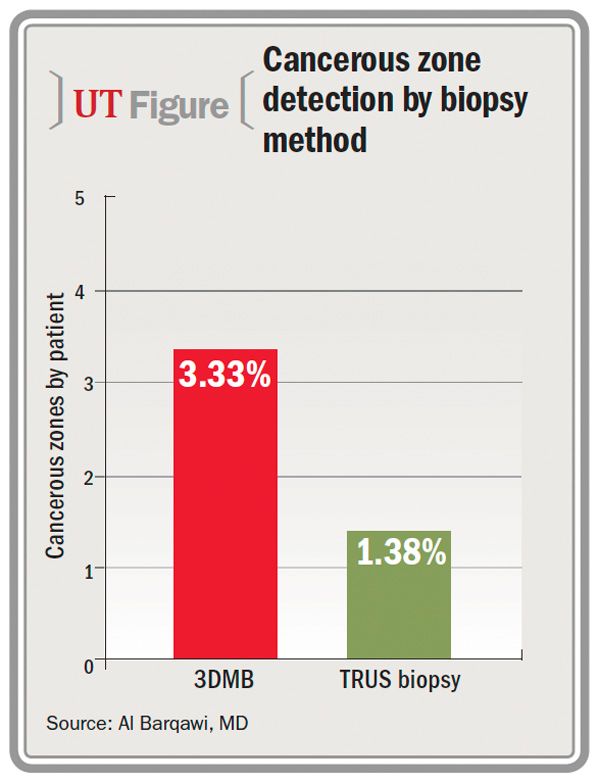Article
3-D mapping enhances accuracy of prostate biopsy
Three-dimensional mapping biopsy (3DMB) of the prostate provides a more accurate disease assessment and in doing so may allow more confident decision making when patients and their physicians are trying to resolve issues surrounding observation or more aggressive therapies, a study from the University of Colorado School of Medicine, Denver, suggests.
Denver-Three-dimensional mapping biopsy (3DMB) of the prostate provides a more accurate disease assessment and in doing so may allow more confident decision making when patients and their physicians are trying to resolve issues surrounding observation or more aggressive therapies, a study from the University of Colorado School of Medicine, Denver suggests.
The study's authors say the 3DMB procedure can significantly reduce both understaging of cancer and overtreatment of the disease.

Continue to next page for more.
"The 3-D biopsy is a systemic approach to the whole prostate compared to transrectal ultrasound [TRUS]-guided biopsies, which have a degree of randomness and may have a sampling error of 30% or higher. Earlier studies have shown that three-dimensional mapping can be up to 99% accurate," senior author Al Barqawi, MD, told Urology Times.
Other advantages of the procedure include more reliable staging of the cancer leading to a reduction of overtreatment, and accurate localization of tumors as a template for targeted focal therapies, said Dr. Barqawi, associate professor of surgery at the University of Colorado School of Medicine.
The study, which was published online in Advances in Urology (Dec. 29, 2013), compared the findings of TRUS 12-core biopsy with 3DMB in 161 men (mean age, 61.9±7.3 years) with either low-risk, organ-confined prostate cancer (Gleason 3+4=7, ≤50% tumor burden, and PSA <10.0 ng/dL) or a high suspicion of cancer.
The mean duration between TRUS biopsy and 3DMB was 192.18±287.96 days. The number of cores taken with 3DMB ranged from 27 to 124 with the mean being 61.4. The number of 3DMB cores found to be positive was 5.25 ±4.81.
The 3DMB identified nearly three times as many cancerous zones as did the TRUS biopsy: 3.33 per patient versus 1.38 per patient.
Fifty-six patients (34.8%) had their cancers upgraded by 3DMB. The initial TRUS biopsies identified 121 patients (75%) with Gleason 6 cancer and 12 (7.5%) with Gleason 7. The 3DMB identified Gleason 6 cancer in 87 patients (54%), Gleason 7 in 40 (25%), Gleason 8 in seven (4%), and Gleason 9 in three (2%).
Continue to next page for more.
Technique finds cancers TRUS misses
The study offered a general idea as to where the TRUS-missed cancers lurked. 3DMB found 62 cancers in the left-mid section of the prostate, 62 cancers in the right-mid section, and 41 cancers in the left apex zone, all of which were missed by the initial TRUS biopsy. Operating time averaged 60 minutes, with the actual biopsy time ranging from 15 to 25 minutes.
Dr. Barqawi said that 3DMB is not to be used as a screening tool. It is more properly used in three clinical instances: in patients with rising PSAs but negative biopsies, in men who want more comprehensive information when deciding between observation and intervention, and in those considering focal therapies such as cryoablation.

Dr. Barqawi"It is not for screening. I offer it to patients who have had multiple TRUS biopsies that are negative but still have persistent elevated PSA. I have had patients who have had as many as 12 TRUS biopsies and their PSA is still rising. Another instance is the patient whose TRUS biopsy has found Gleason 6 and wants to know whether it should be watched or removed. I use mapping biopsy to find out if it is truly low-grade cancer. It has found more aggressive cancers more than 25% of the time," Dr. Barqawi told Urology Times.
"The take-home is that we should avoid overtreating prostate cancer,” he said. “We need more research into technologies that will more accurately assess the true stage of the disease. This [3DMB] is just the starting point. The next step will be the development of imaging and genetic prediction technologies that will give us all the information 3DMB provides and exceed that with personalized risk stratification information.”UT
Like this article? Check out these other recent Urology Times articles:
One-fourth of men drop out of prostate cancer surveillance
MRI guiding future of prostate cancer diagnosis
Higher surgeon volume linked to lower RALP costs
Subscribe to Urology Times to get monthly news from the leading news source for urologists.



